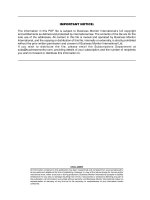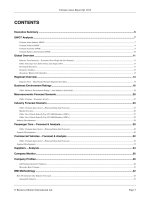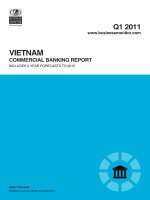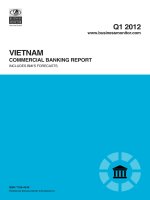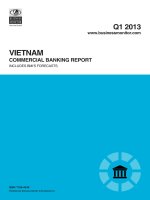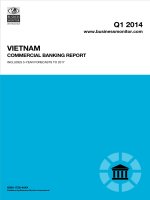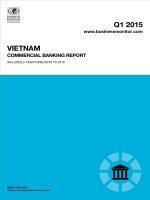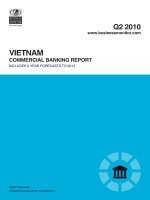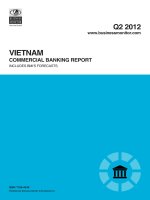Vietnam commercial banking report q1 2012
Bạn đang xem bản rút gọn của tài liệu. Xem và tải ngay bản đầy đủ của tài liệu tại đây (515.86 KB, 66 trang )
Q1 2012
www.businessmonitor.com
COMMERCIAL BANKING REPORT
ISSN 1758-454X
Published by Business Monitor International Ltd.
VIETNAM
INCLUDES BMI'S FORECASTS
Business Monitor International
85 Queen Victoria Street
London
EC4V 4AB
UK
Tel: +44 (0) 20 7248 0468
Fax: +44 (0) 20 7248 0467
Email:
Web:
© 2011 Business Monitor International.
All rights reserved.
All information contained in this publication is
copyrighted in the name of Business Monitor
International, and as such no part of this publication
may be reproduced, repackaged, redistributed, resold in
whole or in any part, or used in any form or by any
means graphic, electronic or mechanical, including
photocopying, recording, taping, or by information
storage or retrieval, or by any other means, without the
express written consent of the publisher.
DISCLAIMER
All information contained in this publication has been researched and compiled from sources believed to be accurate and reliable at the time of
publishing. However, in view of the natural scope for human and/or mechanical error, either at source or during production, Business Monitor
International accepts no liability whatsoever for any loss or damage resulting from errors, inaccuracies or omissions affecting any part of the
publication. All information is provided without warranty, and Business Monitor International makes no representation of warranty of any kind as
to the accuracy or completeness of any information hereto contained.
VIETNAM
COMMERCIAL BANKING
REPORT Q1 2012
INCLUDING 5-YEAR INDUSTRY FORECASTS TO 2016
Part of BMI’s Industry Report & Forecasts Series
Published by: Business Monitor International
Copy deadline: December 2011
Vietnam Commercial Banking Report Q1 2012
© Business Monitor International Ltd Page 2
Vietnam Commercial Banking Report Q1 2012
© Business Monitor International Ltd Page 3
CONTENTS
Executive Summary 5
Table: Levels (VNDbn) 5
Table: Levels (US$bn) 5
Table: Levels At March 2011 5
Table: Annual Growth Rate Projections 2011-2015 (%) 6
Table: Ranking Out Of 59 Countries Reviewed In 2011 6
Table: Projected Levels (VNDbn) 6
Table: Projected Levels (US$bn) 6
SWOT Analysis 7
Vietnam Commercial Banking SWOT 7
Vietnam Political SWOT 7
Vietnam Economic SWOT 8
Vietnam Business Environment SWOT 9
Business Environment Outlook 10
Commercial Banking Business Environment Ratings 10
Table: Vietnam’s Commercial Banking Business Environment Rating 10
Commercial Banking Business Environment Rating Methodology 11
Table: Asia Commercial Banking Business Environment Ratings 12
Global Commercial Banking Outlook 13
Asia Banking Sector Outlook 22
Table: Banks’ Bond Portfolios 28
Table: Asia Commercial Banking Business Environment Ratings 29
Table: Comparison Of Loan/Deposit, Loan/Asset And Loan/GDP Ratios 30
Table: Anticipated Developments In 2012 31
Table: Comparison Of Total Assets, Client Loans And Client Deposits (US$bn) 32
Table: Comparison Of Per Capita Deposits, 2011f (US$) 33
Table: Interbank Rates And Bond Yields 34
Vietnam Banking Sector Outlook 35
Economic Outlook 39
Table: Vietnam Economic Activity, 2011-2016 41
Company Profiles 42
Vietcombank 42
Table: Key Statistics For Vietcombank, 2004-2008 (VNDmn) 43
BIDV 44
Table: Key Statistics For BIDV, 2004-2006 (VNDmn) 45
VietinBank 46
Table: Key Statistics For VietinBank, 2005-2008 (VNDmn) 47
Agribank 48
Table: Balance Sheet, 2004-2008 (VNDmn) 49
Table: Balance Sheet, 2004-2008 (US$mn) 49
Table: Key Ratios, 2004-2008 (%) 49
Vietnam Commercial Banking Report Q1 2012
© Business Monitor International Ltd Page 4
MHB Bank 50
Table: Key Statistics For MHB Bank, 2006-2008 (VNDmn) 51
Eximbank 52
Table: Balance Sheet (VNDmn, unless stated), 2005-2008 53
Table: Balance Sheet (US$mn, unless stated), 2005-2008 53
Table: Key Ratios (%),2005-2008 53
Sacombank 54
Table: Stock Market Indicators, 2005-2009 55
Table: Balance Sheet (VNDmn, unless stated), 2005-2009 55
Table: Balance Sheet (US$mn, unless stated), 2005-2009 56
Table: Key Ratios (%),2005-2009 56
Saigonbank 57
Table: Stock Market Indicators 57
Table: Balance Sheet (VNDmn, unless stated) 58
Table: Balance Sheet (US$mn, unless stated) 58
Table: Key Ratios (%) 58
SeABank 59
Table: Balance Sheet (VNDmn, unless stated) 60
Table: Balance Sheet (US$mn, unless stated) 60
Table: Key Ratios (%) 60
BMI Banking Sector Methodology 61
Commercial Bank Business Environment Ratings 62
Table: Commercial Banking Business Environment Indicators And Rationale 63
Table: Weighting Of Indicators 64
Vietnam Commercial Banking Report Q1 2012
© Business Monitor International Ltd Page 5
Executive Summary
Table: Levels (VNDbn)
Date
Total
assets
Client
loans
Bond
portfolio
Other
Liabilities
and capital
Capital
Client
deposits
Other
March
2010 2,342,752.9
1,935,790.0
159,117.9
247,845.0
2,342,752.9
336,053.0
1,771,242.5
235,457.4
March
2011 3,092,978.4
2,584,860.0
225,505.0
282,613.4
3,092,978.4
479,064.0
2,220,589.1
393,325.3
Change,
% 32%
34%
42%
14%
32%
43%
25%
67%
Source: BMI; Central banks; Regulators
Table: Levels (US$bn)
Date
Total
assets
Client
loans
Bond
portfolio
Other
Liabilities and
capital
Capital
Client
deposits
Other
March
2010
122.8
101.4
8.3
13.0
122.8
17.6
92.8
12.3
March
2011
148.0
123.7
10.7923
13.5
148.0
22.9
106.3
18.8
Change,
% 21%
22%
29%
4%
21%
30%
15%
53%
Source: BMI; Central banks; Regulators
Table: Levels At March 2011
Loan/deposit ratio Loan/asset ratio
Loan/GDP ratio
GDP Per Capita,
US$
Deposits per
capita, US$
116.40% 83.57%
124.04%
1,068
1,206
Rising Rising
Falling
Source: BMI; Central banks; Regulators
Vietnam Commercial Banking Report Q1 2012
© Business Monitor International Ltd Page 6
Table: Annual Growth Rate Projections 2011-2015 (%)
Assets
Loans
Deposits
Annual Growth Rate 20
20
14
CAGR 21
21
14
Ranking 4
2
13
Source: BMI; Central banks; Regulator
Table: Ranking Out Of 59 Countries Reviewed In 2011
Loan/deposit ratio Loan/asset ratio
Loan/GDP ratio
8 1
10
Local currency asset growth
Local currency loan growth
Local currency deposit growth
2 2
9
Source: BMI; Central banks; Regulators
Table: Projected Levels (VNDbn)
2008
2009
2010
2011f
2012f
2013f 2014f
2015f
2016f
Total assets 1,747,335 2,286,351 2,953,153 3,720,973 4,614,007 5,536,808 6,644,170 7,973,004 9,567,605
Client loans 1,339,260 1,869,260 2,475,540 3,119,180 3,867,784 4,641,340 5,569,608 6,683,530 8,020,236
Client deposits 1,341,143 1,680,717 2,209,896 2,651,875 3,076,175 3,506,840 3,997,798 4,557,489 5,195,538
f = BMI forecast. Source: BMI; Central banks; Regulators
Table: Projected Levels (US$bn)
2008
2009
2010
2011f
2012f
2013f
2014f
2015f 2016f
Total assets 99.94
123.79
151.46
180.19
223.44
275.46
340.73
419.63
517.17
Client loans 76.60
101.21
126.96
151.05
187.30
230.91
285.62
351.76
433.53
Client deposits 76.71
91.00
113.34
128.42
148.97
174.47
205.02
239.87
280.84
f = BMI forecast. Source: BMI; Central banks; Regulators
Vietnam Commercial Banking Report Q1 2012
© Business Monitor International Ltd Page 7
SWOT Analysis
Vietnam Commercial Banking SWOT
Strengths
Rapid growth.
Untapped potential.
Weaknesses
Domestic banks lack capital and technology to sustain high credit growth.
The financial accounts of many banks are still opaque.
Opportunities
Population still under-banked.
Income levels likely to rise strongly over the medium term.
Threats
Macroeconomic instabilities threaten the credibility of the government and could
potentially drive economic policy away from further liberalisation.
Vietnam Political SWOT
Strengths
The Communist Party of Vietnam remains committed to market-oriented
reforms and we do not expect major shifts in policy direction over the next
five years. The one-party system is generally conducive to short-term
political stability.
Relations with the US have witnessed a marked improvement, and
Washington sees Hanoi as a potential geopolitical ally in South East Asia.
Weaknesses
Corruption among government officials poses a major threat to the
legitimacy of the ruling Communist Party.
There is increasing (albeit still limited) public dissatisfaction with the
leadership’s tight control over political dissent.
Opportunities
The government recognises the threat corruption poses to its legitimacy, and
has acted to clamp down on graft among party officials.
Vietnam has allowed legislators to become more vocal in criticising
government policies. This is opening up opportunities for more checks and
balances within the one-party system.
Threats
Macroeconomic instabilities in 2010 and 2011 are likely to weigh on public
acceptance of the one-party system, and street demonstrations to protest
economic conditions could develop into a full-on challenge of undemocratic
rule.
Although strong domestic control will ensure little change to Vietnam’s
political scene in the next few years, over the longer term, the one-party-
state will probably be unsustainable.
Relations with China have deteriorated over recent years due to Beijing’s
more assertive stance over disputed islands in the South China Sea and
domestic criticism of a large Chinese investment into a bauxite mining
project in the central highlands, which could potentially cause wide-scale
environmental damage.
Vietnam Commercial Banking Report Q1 2012
© Business Monitor International Ltd Page 8
Vietnam Economic SWOT
Strengths
Vietnam has been one of the fastest-growing economies in Asia in recent
years, with GDP growth averaging 7.2% annually between 2000 and 2010.
The economic boom has lifted many Vietnamese out of poverty, with the
official poverty rate in the country falling from 58% in 1993 to 12.0% in 2009.
Weaknesses
Vietnam still suffers from substantial trade, current account and fiscal
deficits, leaving the economy vulnerable to global economic uncertainties in
2011. The fiscal deficit is dominated by substantial spending on social
subsidies that could be difficult to withdraw.
The heavily-managed and weak dong currency reduces incentives to
improve quality of exports, and also keeps import costs high, contributing to
inflationary pressures.
Opportunities
WTO membership has given Vietnam access to both foreign markets and
capital, while making Vietnamese enterprises stronger through increased
competition.
The government will in spite of the current macroeconomic woes, continue to
move forward with market reforms, including privatisation of state-owned
enterprises, and liberalising the banking sector.
Urbanisation will continue to be a long-term growth driver. The UN forecasts
the urban population rising from 29% of the population to more than 50% by
the early 2040s.
Threats
Inflation and deficit concerns have caused some investors to re-assess their
hitherto upbeat view of Vietnam. If the government focuses too much on
stimulating growth and fails to root out inflationary pressure, it risks
prolonging macroeconomic instability, which could lead to a potential crisis.
Prolonged macroeconomic instability could prompt the authorities to put
reforms on hold as they struggle to stabilise the economy.
Vietnam Commercial Banking Report Q1 2012
© Business Monitor International Ltd Page 9
Vietnam Business Environment SWOT
Strengths
Vietnam has a large, skilled and low-cost workforce, that has made the
country attractive to foreign investors.
Vietnam’s location - its proximity to China and South East Asia, and its good
sea links - makes it a good base for foreign companies to export to the rest
of Asia, and beyond.
Weaknesses
Vietnam’s infrastructure is still weak. Roads, railways and ports are
inadequate to cope with the country’s economic growth and links with the
outside world.
Vietnam remains one of the world’s most corrupt countries. Its score in
Transparency International’s 2010 Corruption Perceptions Index was 2.7,
placing it in 22nd in the Asia-Pacific region.
Opportunities
Vietnam is increasingly attracting investment from key Asian economies,
such as Japan, South Korea and Taiwan. This offers the possibility of the
transfer of high-tech skills and know-how.
Vietnam is pressing ahead with the privatisation of state-owned enterprises
and the liberalisation of the banking sector. This should offer foreign
investors new entry points.
Threats
Ongoing trade disputes with the US, and the general threat of American
protectionism, which will remain a concern.
Labour unrest remains a lingering threat. A failure by the authorities to boost
skills levels could leave Vietnam a second-rate economy for an indefinite
period.
Vietnam Commercial Banking Report Q1 2012
© Business Monitor International Ltd Page 10
Business Environment Outlook
Commercial Banking Business Environment Ratings
Table: Vietnam’s Commercial Banking Business Environment Rating
Limits of potential returns Data
Score; out of 10
Ratings score; out of 100
Total assets; end 2010 US$151.5mn
6
Market Structure 63
Growth in total assets; 2011-
2015
239,439.4
6
Growth in client loans; 2011-
2015
200,714.9
7
Per-capita GDP; 2011 US$1,353.7
2
Country Structure 53
Tax 2.9
3
GDP volatility 0.4
10
Financial infrastructure 5.6
6
Risks to realisation of returns
Regulatory framework and
development 4.5
5
Market Risk 40
Regulatory framework and
competitive landscape 5.0
5
Moody’s rating for local
currency deposits 2.0
2
Long-term financial risk 4.8
5
Country Risk 46
Long-term external risk 3.3
3
Long-term policy continuity 7.0
7
Legal framework 3.7
4
Bureaucracy 3.9
4
Commercial banking business environment rating
54
Source: BMI
Vietnam Commercial Banking Report Q1 2012
© Business Monitor International Ltd Page 11
Commercial Banking Business Environment Rating Methodology
Since Q108, we have described numerically the banking business environment for each of the countries
surveyed by BMI. We do this through our Commercial Banking Business Environment Rating (CBBER),
a measure that ensures we capture the latest quantitative information available. It also ensures consistency
across all countries and between the inputs to the CBBER and the Insurance Business Environment
Rating, which is likewise now a feature of our insurance reports. Like the Business Environment Ratings
calculated by BMI for all the other industries on which it reports, the CBBER takes into account the
limits of potential returns and the risks to the realisation of those returns. It is weighted 70% to the former
and 30% to the latter.
The evaluation of the ‘Limits of potential returns’ includes market elements that are specific to the
banking industry of the country in question and elements that relate to that country in general. Within the
70% of the CBBER that takes into account the ‘Limits of potential returns’, the market elements have a
60% weighting and the country elements have a 40% weighting. The evaluation of the ‘Risks to
realisation of returns’ also includes banking elements and country elements (specifically, BMI’s
assessment of long-term country risk). However, within the 30% of the CBBER that take into account the
risks, these elements are weighted 40% and 60%, respectively.
Further details on how we calculate the CBBER are provided at the end of this report. In general, though,
three aspects need to be borne in mind in interpreting the CBBERs. The first is that the market elements
of the ‘Limits of potential returns’ are by far the most heavily weighted of the four elements. They
account for 60% of 70% (or 42%) of the overall CBBER. Second, if the market elements are significantly
higher than the country elements of the ‘Limits of potential returns’, it usually implies that the banking
sector is (very) large and/or developed relative to the general wealth, stability and financial infrastructure
in the country. Conversely, if the market elements are significantly lower than the country elements, it
usually means that the banking sector is small and/or underdeveloped relative to the general wealth,
stability and financial infrastructure in the country. Third, within the ‘Risks to the realisation of returns’
category, the market elements (ie: how regulations affect the development of the sector, how regulations
affect competition within it, and Moody’s Investor Services’ ratings for local currency deposits) can be
markedly different from BMI’s long-term risk rating.
Vietnam Commercial Banking Report Q1 2012
© Business Monitor International Ltd Page 12
Table: Asia Commercial Banking Business Environment Ratings
Limits of Potential
Returns
Risks to Potential
Returns Overall
Market
Structure
Country
Structure
Market
Risks
Country
Risks
Rating
Ranking
Bangladesh 43.3
45.0
30.0
44.0
42.3
57
China 93.3
52.5
56.7
76.0
74.4
11
Hong Kong 73.3
92.5
70.0
84.0
80.2
5
India 83.3
57.5
53.3
56.0
67.6
20
Indonesia 73.3
62.5
76.7
42.0
65.1
25
Japan 33.3
77.5
63.3
78.0
57.3
38
Malaysia 73.3
80.0
76.7
78.0
76.4
9
Pakistan 43.3
50.0
56.7
36.0
45.5
53
Philippines 50.0
62.5
56.7
52.0
54.7
41
Singapore 70.0
95.0
96.7
84.0
82.7
4
Sri Lanka 23.3
55.0
36.7
46.0
37.9
58
South Korea 80.0
85.0
76.7
70.0
79.2
6
Taiwan 76.7
72.5
83.3
74.0
75.8
10
Thailand 60.0
65.0
80.0
68.0
65.2
23
Vietnam 63.3
52.5
40.0
46.0
54.4
43
United States 90.0
85.0
100.0
74.0
86.9
2
Scores out of 100, with 100 the highest. Source: BMI
Vietnam Commercial Banking Report Q1 2012
© Business Monitor International Ltd Page 13
Global Commercial Banking Outlook
Europe On The Brink
The biggest risk to the global commercial banking sector remains the European crisis, with the worst-case
scenario of a euro bloc breakup looming large in the background, and the health of the global banking
sector hanging in the balance. Our core global economic view is that the world is not about to enter a
double-dip recession, but that weak ongoing growth leaves the global economy fragile, and thus
susceptible to a major shock. A disorderly eurozone breakup would have devastating consequences for
core eurozone banks, given their exposure to peripheral eurozone debt. Furthermore, with sovereign bond
spreads soaring, commercial banks exposed to European debt are seeing their balance sheets erode, with
the effect compounded by a weak economy hurting lending conditions. The market is discounting a
negative outcome for bank asset value, with European and US bank shares trading well below book value.
We stress that our core scenario for the eurozone is one of ‘muddle through’ rather than ‘meltdown’.
Furthermore, the exact path of events in the eurozone is difficult to predict, with potential outcomes
including a full breakup of the monetary union, to austerity-induced recession, to European Central Bank
support for the banking sector. However, it is worth looking at the potential contagion risks from a
European financial crisis. Looking at the commercial banking universe covered by BMI, direct exposure
to the weakest links in the eurozone is fairly limited, and is (unsurprisingly) most prevalent in European
states. We are also acutely aware of the potential for contagion from a European financial crisis into
emerging markets. However, looking at the data, emerging market exposure is mainly concentrated in
Emerging Europe, as one would expect given the significant degree of banking sector integration across
the continent over the past two decades. Furthermore, emerging markets tend to be exposed to the
European banking sector on the liabilities side, far more than on the assets side (in other words, they are
in danger of having European banks pulling lending from their economies). The following chart shows
European banks’ lending as a percentage of the destination country’s GDP. Unsurprisingly, major
financial centres figure prominently (eg Hong Kong, Singapore and the UK), as do emerging European
economies.
Vietnam Commercial Banking Report Q1 2012
© Business Monitor International Ltd Page 14
If European Banks Pull Out, How Bad Would It Be?
European Cross-Border Bank Lending To Country As % of Country’s GDP
(Excluding Eurozone)
Source: BMI, Bank for International Settlements
The accompanying chart draws upon Bank for International Settlements (BIS) data, and shows cross-
border bank lending to the ‘PIIGS’ (Portugal, Ireland, Italy, Greece and Spain) as a percentage of
commercial banking sectors’ total foreign lending exposure. Here, core eurozone banking sectors
including Germany and France’s, and major developed markets such as the UK, are heavily exposed.
Vietnam Commercial Banking Report Q1 2012
© Business Monitor International Ltd Page 15
Emerging Markets Fairly Well
-
Insulated From Direct Exposure
Lending To PIIGS As % of Total Foreign Lending Exposure
Source: BMI, Bank for International Settlements
Looking solely at our commercial banking universe, lending exposure to the PIIGS as a percentage of
national commercial banking systems’ assets shows that Austria, Germany and France are the most
heavily exposed to a peripheral eurozone crisis. These exposures are relatively small, as they do not
include sovereign bond holdings, but they show fairly clearly that a) the core eurozone states are the most
exposed, and b) emerging markets are not heavily exposed, at least not directly. As the Lehman Brothers
crisis taught us, however, the collapse of a major financial institution can have wide-reaching and
unpredictable effects.
Vietnam Commercial Banking Report Q1 2012
© Business Monitor International Ltd Page 16
Core Eurozone Most Exposed To Periphery
Exposure To PIIGS As % of Banking Sector Assets
Source: BMI, Bank for International Settlements
EM: Regional Outlooks
On a region-by-region basis, the risks to emerging commercial banking sectors come largely from abroad,
with economic growth in Europe, the US and China all set to slow, and the eurozone crisis rumbling on.
Emerging Asia: The regional outlook for Asian banks has deteriorated significantly in recent months, as
the yet unresolved European fiscal debt crisis as well as sluggish US growth threatens economic growth
within Asia. Moreover, there is also the significant threat of a reduction of European lending to Asian
banks, both in terms of trade financing and longer-term business loans – that may threaten to destabilise
the balance sheets of lenders within the Asian region. In addition, we believe Asian banks will also have
to contend with an abrupt slowdown in Chinese economic growth, led by a steep contraction in domestic
money supply growth that should constrain lending activity and hence, overall activity within China.
Vietnam Commercial Banking Report Q1 2012
© Business Monitor International Ltd Page 17
Some Biting Off More Than They Can
Chew
Asia – Loan-To-Deposit Ratio, %
Source: BMI
Latin America: Massive capital inflows since late 2009, particularly into the more dynamic South
American economies, has increased the risk of tighter liquidity exposing weaknesses in banks’ balance
sheets, concerns which were reinforced following the wealth of headlines about dubious lending practices
in Brazil and Chile, the region’s two most developed banking sectors. Yet despite the selloff in equities,
to date no country has suffered a major threat to its banking sector from external headwinds, and in our
view, any systemic risks that do emerge will be home grown, prompted by excessively loose monetary
conditions and/or too much state intervention in local credit markets. The countries’ we believe are most
exposed to this risk are Argentina and Venezuela, with the others set to suffer no more than a cyclical
slowdown in credit growth and subdued profitability as regulators enforce stricter provisions for bad
credit. The one possible exception is Brazil, where the authorities’ desire to maintain strong economic
growth may yet harm financial stability, although our core scenario remains for a period of consolidation
followed by a more sustainable growth trajectory.
Vietnam Commercial Banking Report Q1 2012
© Business Monitor International Ltd Page 18
Few Have Grown As Aggressively As Brazil
Change In Commercial Banks’ Assets % GDP Between 2004-2010, pp
Source: BMI, central banks, banking supervisory bodies
Emerging Europe: We maintain our broadly constructive view on Central and Eastern European banking
sectors due to lower levels of leverage as compared to Western European banks and more sound
macroeconomic backdrops that will help promote growth and we expect the broad-based recovery to
continue at a relatively slow pace in most markets. However, we caution that risks to this outlook are
mounting in light of the ongoing eurozone debt crisis and signs that the global slowdown may be more
sustained than we had previously expected. Indeed, we expect this continued moderation of economic
expansion combined with more cautious lending practices to weigh on banks’ profitability going forward.
We also believe that given the less supportive external environment, banking sectors with a more
domestic focused funding structure are better placed to weather the slowdown (we view the Czech
Republic and Poland most positively).
Vietnam Commercial Banking Report Q1 2012
© Business Monitor International Ltd Page 19
Generally Slow Recovery In Europe With Few Outliers
Central and Eastern Europe – Loan Growth, % chg y-o-y
Source: central banks
Sub-Saharan Africa: The outlook is mixed for the three major Sub-Saharan African markets covered by
BMI – the South African, Nigerian and Kenyan banking sectors. We see Nigeria as having the strongest
growth potential over the short term, while South Africa should see slow but stable expansion, and Kenya
will likely struggle amid various macroeconomic challenges.
Vietnam Commercial Banking Report Q1 2012
© Business Monitor International Ltd Page 20
A Mixed Bag
Kenya, Nigeria & South Africa – Banking Sector Asset Growth, % y-o-y
Source: Central banks, BMI
Middle East & North Africa: The outlook for banking sectors across the region continues to diverge,
with elevated exposure to Europe and lingering political risks likely to see the performance of financial
institutions in North African oil importers lag far behind their hydrocarbon-rich peers in the Gulf. Given
ample liquidity across the region, the main obstacle to a more pronounced ramp up in lending activity
points to elevated risk aversion on the part of many financial institutions. This would seem to suggest that
once fears surrounding the strength of the global economy begin to subside, many banks will be in a solid
position to aggressively ramp up lending, reversing the multi-year trend of single-digit credit expansion
that has prevailed since the burst credit bubble of 2009.
Vietnam Commercial Banking Report Q1 2012
© Business Monitor International Ltd Page 21
Qatar Leading The Way
GCC – Loan Growth, % yoy
Source: BMI/central banks
Vietnam Commercial Banking Report Q1 2012
© Business Monitor International Ltd Page 22
Asia Banking Sector Outlook
Uneven Banking Risk Exposure Across Region
BMI View: Amid the recent slump in global consumer and investor confidence due to economic
instability in the EU and the US, the banking sectors of certain Asian countries are relatively more
exposed than others. With the recent creep-up in the share of mortgage loans as a percentage of total
loans amid a weakening housing sector, we regard Australian banks as the single most vulnerable group
within the region. By contrast, economies such as Singapore and Hong Kong should remain financially
more stable despite facing similar price instability in their respective real estate markets.
The regional outlook for Asian banks have deteriorated significantly in recent months, as the yet
unresolved European fiscal debt crisis as well as sluggish US growth threatens economic growth within
Asia. Moreover, there is also the significant threat of a reduction of European lending to Asian banks,
because such debt makes up about 25% of total foreign lending - both in terms of trade financing and
longer-term business loans - that may threaten to destabilise the balance sheets of lenders within the
Asian region.
In addition, we believe Asian banks will also have to contend with an abrupt slowdown in Chinese
economic growth, led by a steep contraction in domestic money supply growth that should constrain
lending activity and hence, overall activity within China. With the tightening of liquidity, anecdotal
reports of small-to-medium sized enterprises - which have had to resort to raising funds from the shadow
banking system that charges exorbitant interest rates - going bankrupt in cities such as Wenzhou are
beginning to surface.
From a macroeconomic perspective, the slide in real GDP growth in Q311 to 9.1% year-on-year from
9.5% in the preceding quarter, provides support to our view that the country is in its nascent stages of a
prolonged slowdown (see our online service, October 17 2011, ‘No Cure For The Credit Hangover’).
This does not bode well for key trading partners, which are already facing the prospect of lower external
demand from key EU and US buyers. With these factors in mind, we believe banking sectors across the
region will face heightened risks to asset and loan growth, forcing overall industry expansion to slow or
even turn negative.
Vietnam Commercial Banking Report Q1 2012
© Business Monitor International Ltd Page 23
Overreliance On Mortgage Loans
Asia – Mortgage Loans By Country, % of total loans
Sources: RBA, RBNZ, HKMA
Prospect Of Property Slowdown Compounds Fears
Apart from external concerns, we also highlight that certain Asian lenders will be heavily exposed to a
domestic slump in property prices, where economies such as Australia, and Hong Kong having among the
highest exposures, with mortgage loans making up 58.8% and 50.3% of total loans respectively (China is
similarly exposed to a real estate slump as well, although indirectly, through soaring construction loans).
Ominously, growth in property prices in both places have fallen significantly over the past few quarters,
suggesting substantial downward pressure on loan growth for these economies in 2012, turning negative
in countries including Australia and Hong Kong.
Vietnam Commercial Banking Report Q1 2012
© Business Monitor International Ltd Page 24
Smaller Proportion
Asia – Mortgage Loans By Country, % of total loans
Sources: BNM, MAS, BOK
Other key countries with rapidly cooling property prices include Taiwan and Singapore as their respective
administrations have put in place measures to stem a runaway bubble from forming. In Taiwan, the
Kuomintang-led government introduced a property tax on non-self-use properties in June, with the levy
ranging between 10% and 15% depending on the assets’ holding period. In Singapore, National
Development Minister Khaw Boon Wan has accelerated the release of residential land supply, as well as
the number of built-to-order public housing units, in order to meet rising demand. These interim
measures, while detrimental to the banks’ loan books in the short term, should help prevent a sharp
downward shock to the financial industry over the longer term due to a more orderly unwinding of the
property bubble.
